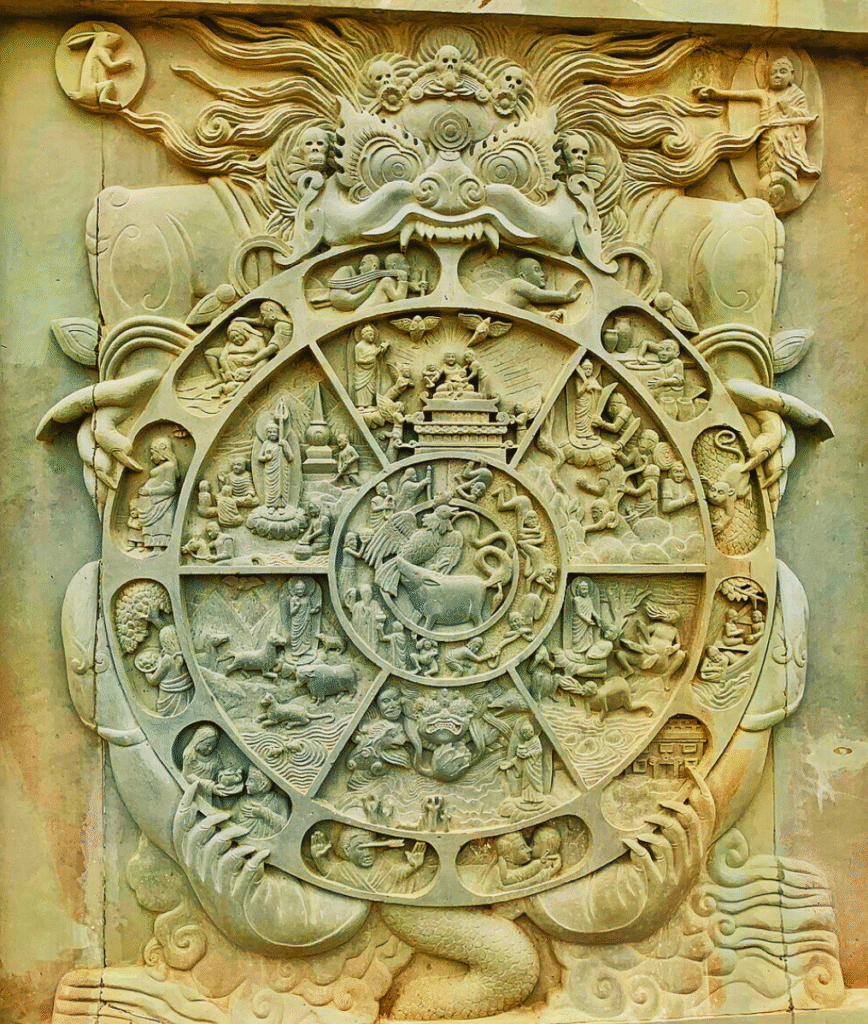The Six Realms of Samsara: The Cycle of Birth and Death in Buddhism

Image: Traditional Bhavachakra panel from India, Wikimedia Commons (public domain)
When we hear the word reincarnation, most people imagine being reborn as a human.
But according to Buddhism, reality is far broader. Samsara—the endless cycle of birth and death—includes six fundamental realms of existence.
These realms can be understood literally, as distinct states of being into which one may be reborn, or symbolically, as psychological states of mind that we experience even within a single lifetime.
The Six Realms of Samsara
1. The Realm of Gods (Deva Loka)
Beings here live in abundance, beauty, and joy. They enjoy long lives, power, and pleasures.
The problem: because of their bliss, they neglect spiritual growth, and when their good karma runs out, they fall into lower realms.
Psychologically: the state of a person who has everything yet loses their sense of meaning.
Example: someone living in luxury, yet feeling empty and asking, “What’s next?”
2. The Realm of Demigods (Asura Loka)
Beings are powerful but full of jealousy and the desire for conflict. They constantly envy the gods and fight for their privileges.
Psychologically: people driven by rivalry, ambition, and endless comparison with others.
Example: workplace rivalries, political struggles, or endless competition on social media.
3. The Human Realm (Manuṣya Loka)
The most precious form of rebirth, because it combines both joy and suffering.
This balance provides the ideal opportunity for spiritual growth and the attainment of enlightenment.
Psychologically: everyday human life, full of challenges but also possibilities.
Example: ordinary life—illness, worries, relationships, joy and sadness—and precisely within this lies the chance for growth.
4. The Animal Realm (Tiryagyoni Loka)
Beings live driven by instinct: survival, eating, sleeping, defending.
There is little room for spiritual development.
Psychologically: people who live only for basic needs, without deeper meaning.
Example: someone who is merely “existing”—work, food, sleep, TV—with little awareness.
5. The Realm of Hungry Ghosts (Preta Loka)
Beings suffer from endless hunger, thirst, or cravings they can never satisfy.
It symbolizes extreme attachment and insatiability.
Psychologically: a person addicted to material things, passions, or desires that never bring fulfillment.
Example: a workaholic, shopaholic, or someone addicted to alcohol or relationships, always chasing “something more.”
6. The Hell Realm (Naraka Loka)
Beings are trapped in painful states—from freezing cold to burning fire.
It is not eternal, but suffering can last a very long time.
Psychologically: states of anger, hatred, depression, and inner torment.
Example: someone living in self-hatred, chronic rage, or constant anxiety.
How is the next rebirth determined?
According to Buddhism, the decisive factors are karma—our actions, words, thoughts, and intentions—
and the state of mind at the moment of death:
- If the mind is calm and compassionate, consciousness may be directed to a higher realm or toward liberation.
- If the mind is full of fear, anger, or craving, it may fall into the lower realms.
This is why Buddhism emphasizes meditation, ethical living, and the cultivation of compassion—so that the mind is as clear and pure as possible.
Why does this matter to modern people?
Even if you don’t believe in reincarnation, the “six realms” can be understood as six psychological states that alternate within a single lifetime:
- Sometimes you live like a “god” in comfort,
- other times like a “hungry ghost” in endless craving,
- or you sink into the “hell” of anger and depression.
Samsara is essentially our own mind—and it is there that it is decided which realm we find ourselves in.
How can we step out of this cycle?
According to the Buddha’s teaching, the goal is not merely to seek a “better rebirth” but to transcend samsara entirely.
This path consists of:
- Ethical living (non-harming, doing good),
- Meditation (training the mind),
- Wisdom (understanding impermanence and the absence of a fixed “self”).
This state of complete liberation is called nirvana—the end of suffering and rebirth.
Conclusion
The six realms of samsara remind us that life is impermanent and that our actions and thoughts carry consequences.
The most precious form of existence is to be born as a human—because here we have the chance to recognize illusion, overcome suffering, and seek liberation.
Even if we approach samsara only symbolically, it can teach us mindfulness:
- to notice which “realm” our mind currently inhabits,
- and step by step move closer to greater peace, compassion, and freedom.

